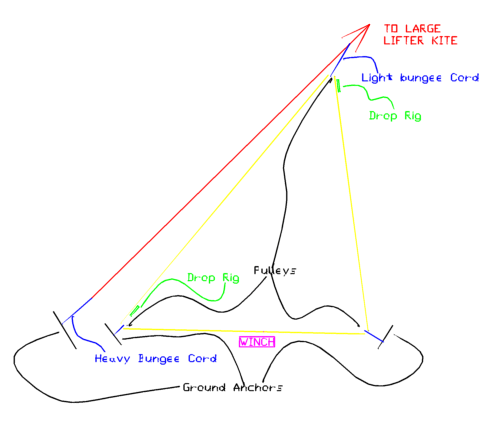
There are many ways of lifting and releasing teddy bears from kites. These include the ferry system where a large kite is used and a trolley sits on the line with a sail attached. This is blown up the line and when it hits a stop at the top the bear is released, the sail collapses and returns the trolley back down the line. A number of good plans for these can be found in the BEAR LINKS. Any large kite is suitable for this system but you do require plenty of tension in the line. Try a parafoil, flow form or sled of 3 to 5 sqm dependant on the wind but don't expect to lift more than about 1kg. A large box kite is also very good for this system and makes a very stable platform. Deltas need to be very big to get enough tension.
A variation on the above technique is to attach a pulley to the kite line about 10m below the kite and run a secondary line up over this and back down and attach it to the trolley. This can then be pulled up the line and a third line used to release the bear(s) and pull the trolley back down. This is the best method I know for lifting very heavy loads and was used in the Vic Walker Class 1 World Record when 101 bears were lofted and 99 successfully jumped. There is no limit to the size of the kite used for this method in fact the bigger the better. Vic used a Stratascoop9 (about 75sqm) for this lift with the total weight lifted in the order of 25kg. I have used a Stratascoop4 (about 7sqm) or a 12sqm para sled to lift bears of about 5kg and bring them to earth on 2 x 3m diameter hemispheric 'chutes.
Both these methods work very well but are relatively slow for displays etc where you want to get a lot of individual bears into the air rapidly. As most domestic bears brought to events weigh in at about 250gm or less the high lifting power is not necessary. Taking these two facts into account my preferred method is the triangle method where two pulleys are fixed to ground anchors about 5m apart and a flying line of about 200m long and 100kg test taken round these then up and round another pulley attached 10m or more below the kite. All three of these pulleys are critical and must be of good quality. They are best bought from yacht chandlers and should be fitted with stainless steel ball races preferably sealed as we tend to get them full of dust or sand.
For this system my favorite lifter is a 4m Megadelta from Sky Bums This kite is very stable and flys at a good high angle so you get plenty of height for the amount of line used. The following picture should give you the idea. It was done as a birthday present to me by Jemma Willis.

The bears are attached to the line by the drop rig. These come in many forms and detailed plans can also be found through the links page. When the rig reaches the top pulley the rod is operated and releases the bear. By careful arrangement another drop rig can be attached to the other side of the system at this point and will then be ready to take another bear up that side.
Pulling this up many times during the day can prove very hard on the hands so I have developed an electric winch system to make life easier.
So that I can cope with varying wind conditions I carry 2 x 4m Megadeltas that can be stacked for low winds, a 2.5m Delta, a 3sqm parasled, a 3sqm parafoil and a range of small Bushel sleds for when the wind picks up. Plans for this one can be found in "More Kites for Everyone" by Margaret Greger or The Kiteflier (April 2003). These can be scaled down to suit your requirements or used full size as an excellent lifter.
An identical system can be used attached to any high platform such as a church tower or fire engine ladder. Just fit another pulley at the suspension point and run a line over this to be able to adjust the height and tension in the rig.
A variation on this system has been developed by Jerry Swift and is still under continual refinement. Rather than than fly the kite off the top pulley a much larger kite is used flown on a single line to a good height. It is anchored separately with a heavy bungee cord. Part way up this line the top pulley is attached using a lighter bungee cord and shackles. Once this has been lifted complete with winch line the position of the two ground anchors for the bottom pulleys can be established and then the remainder of the set up is similar to the previous one.

The benefit of this system is that a much larger kite can be used without putting too much load on the winch hence giving a better load capacity particularly in low wind conditions. The purpose of the bungee cords is to stop the load being transferred to the winch lines as the attitude of the kite changes. The lengths and diameters of these is the major area of current investigation.